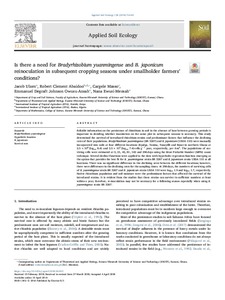| dc.contributor.author | Ulzen, J. |
| dc.contributor.author | Abaidoo, R.C. |
| dc.contributor.author | Masso, C. |
| dc.contributor.author | Owusu-Ansah, E.D.J. |
| dc.contributor.author | Ewusi-Mensah, N. |
| dc.date.accessioned | 2019-12-04T11:26:33Z |
| dc.date.available | 2019-12-04T11:26:33Z |
| dc.date.issued | 2018-07 |
| dc.identifier.citation | Ulzen, J., Abaidoo, R.C., Masso, C., Owusu-Ansah, E.D. J. & Ewusi-Mensah, N. (2018). Is there a need for Bradyrhizobium yuanmingense and B. japonicum reinoculation in subsequent cropping seasons under smallholder farmers’ conditions?. Applied Soil Ecology, 128, 54-60. |
| dc.identifier.issn | 0929-1393 |
| dc.identifier.uri | https://hdl.handle.net/20.500.12478/4650 |
| dc.description | Published online: 10 April 2018. |
| dc.description.abstract | Reliable information on the persistence of rhizobium in soil in the absence of host between growing periods is important in deciding whether inoculation on the same plot in subsequent seasons is necessary. This study determined the survival of introduced rhizobium strains and predominant factors that influence the declining rates of their populations. Bradyrhizobium yuanmingense (BR 3267) and B. japonicum (USDA 110) were manually incorporated into soils at four different locations (Kpalga, Tanina, Tunayilli and Busa) in northern Ghana at 2.5 × 108 (log10 8.4) and 2.5 × 107 (log10 7.4) cells g−1 peat, respectively, per 6 m2. The populations of surviving cells were estimated at 0, 21, 42, 81, 142 and 296 days using the Most Probable Number (MPN) count technique. Several decline functions were applied to the data with hyperbolic regression function emerging as the option that provides the best fit for B. yuanmingense strain BR 3267 and B. japonicum strain USDA 110 at all locations. There was no significant difference in the declining rates between the different locations; however, there were differences in the declining rates for the sampling times. At 296 days, the numbers of surviving cells of B. yuanmingense strain BR 3267 and B. japonicum strain USDA 110 were log10 1.9 and log10 1.7, respectively. Native rhizobium population and soil moisture were the predominant factors that affected the survival of the introduced strains. It is evident from the studies that these strains can survive in sufficient numbers at least within a year; therefore, re-inoculation may not be necessary for a following season especially when using B. yuanmingense strain BR 3267. |
| dc.description.sponsorship | Bill & Melinda Gates Foundation |
| dc.format.extent | 54-60 |
| dc.language.iso | en |
| dc.rights | Other |
| dc.subject | Legumes |
| dc.subject | Soil |
| dc.subject | Abiotic Stress |
| dc.subject | Ghana |
| dc.subject | West Africa |
| dc.title | Is there a need for Bradyrhizobium yuanmingense and B. japonicum reinoculation in subsequent cropping seasons under smallholder farmers' conditions? |
| dc.type | Journal Article |
| dc.description.version | Peer Review |
| cg.contributor.crp | Grain Legumes and Dryland Cereals |
| cg.contributor.affiliation | Kwame Nkrumah University of Science and Technology |
| cg.contributor.affiliation | International Institute of Tropical Agriculture |
| cg.coverage.region | Africa |
| cg.coverage.region | West Africa |
| cg.coverage.country | Ghana |
| cg.creator.identifier | Robert Abaidoo: 0000-0002-1235-2252 |
| cg.creator.identifier | Cargele Masso: 0000-0002-3980-6832 |
| cg.researchtheme | NATURAL RESOURCE MANAGEMENT |
| cg.isijournal | ISI Journal |
| cg.authorship.types | CGIAR and developing country institute |
| cg.iitasubject | Grain Legumes |
| cg.iitasubject | Natural Resource Management |
| cg.journal | Applied Soil Ecology |
| cg.howpublished | Formally Published |
| cg.accessibilitystatus | Limited Access |
| local.dspaceid | 101396 |
| cg.targetaudience | Scientists |
| cg.identifier.doi | https://doi.org/10.1016/j.apsoil.2018.04.003 |

